Are you someone who loves spending time on the water, whether it’s for fishing, sailing, or simply enjoying a day out in a boat? If so, it’s crucial to have some knowledge about boat knots and ties. Understanding how to recognize and handle different types of boat knots can make your time on the water safer and more efficient. In this article, we’ll explore the various types of boat knots and ties, why they are important, and how to use them effectively. So, whether you’re a novice or an experienced boater, read on to sharpen your skills and master the art of knot-tying on the water.
Understanding the Basics of Boat Knots
Boat knots are an essential skill that every boater should possess. Whether you’re an avid sailor, a weekend cruiser, or a fishing enthusiast, knowing how to tie different types of knots is crucial for safety and functionality on the water. By understanding the basics of boat knots, you can secure lines, attach ropes, join lines, and prevent line slippage. With the right knowledge and practice, you’ll be able to handle various boating situations with ease.
The Importance of Knowing Boat Knots and Ties
Knowing how to tie boat knots is not just about impressing your fellow boaters or adding another skill to your repertoire. It is a matter of safety and efficiency on the water. By mastering different types of knots, you can ensure that lines are secure, attachments are strong, and lines won’t slip under pressure. This knowledge can make a significant difference in boating emergencies, docking maneuvers, and overall seamanship. It also allows you to handle a wide range of boating situations confidently.
Different Types of Knots Used in Boating
Boating utilizes various types of knots, each serving a specific purpose. Loop knots are used to secure lines to objects or create adjustable loops. Hitch knots allow you to attach lines to objects quickly and easily. Bend knots are used for joining two ropes together. Stopper knots prevent lines from slipping through objects or fittings, and decorative knots add both aesthetics and functionality. Lastly, specialty knots are designed for specific boating needs such as anchoring or tying off to a bight. Understanding the different types of knots and their applications is essential for any boater.
Essential Tools and Materials for Knot Tying
Before diving into the world of boat knots, it’s important to have the necessary tools and materials. A good knife or pair of scissors is essential for cutting rope cleanly and safely. It’s also helpful to have a fid or marlinspike, which is a pointed tool used for splicing ropes or opening up tight knots. Additionally, having a supply of rope or line of different diameters and materials will allow you to practice and handle a variety of boating tasks. Nylon, polyester, and polypropylene are common rope materials, each with its own advantages and disadvantages. Having these tools and materials on hand will enable you to tackle various knot tying scenarios with ease.
Loop Knots for Securing Lines
Loop knots are versatile knots used in boating for securing lines to objects or creating adjustable loops. They allow for easy adjustment and are ideal for situations where you need to create a non-permanent fastening.
The Versatile Bowline Knot
The bowline knot is one of the most important knots to master in boating. It forms a fixed-loop at the end of a line and is commonly used for securing the line to a post or a ring. The bowline knot is known for its strength and reliability, as well as its ability to be easily untied even after being subjected to heavy loads. Learning how to tie a bowline knot is an essential skill for any boater.
Creating a Secure Figure Eight Knot
The figure eight knot is another loop knot commonly used in boating. It is easy to tie and untie, and it provides a secure way to create a loop at the end of a line. This knot is particularly useful when you need a strong and reliable loop that won’t slip or come undone. It is commonly used for attaching a line to a cleat or securing items on the deck of a boat.
Using the Slip Knot for Temporary Fastening
The slip knot is a simple but effective knot that allows for easy adjustment and temporary fastening. It is commonly used in boating for attaching fenders, creating adjustable loops, or securing lightweight items. The slip knot should be used with caution, as it can come undone if subjected to heavy loads or sudden movements. However, in situations where adjustability and temporary fastening are required, the slip knot is a valuable knot to know.
Hitch Knots for Attaching Lines
Hitch knots are used in boating to quickly and securely attach lines to objects such as poles, rings, or cleats. They are easy to tie and untie and are ideal for situations where you need a reliable attachment that can be easily adjusted or removed.
The Reliable Clove Hitch
The clove hitch is a versatile and widely used hitch knot in boating. It is easy to tie and untie, and it provides a secure attachment to a variety of objects, such as poles, posts, or even other lines. The clove hitch is particularly useful in situations where you need to temporarily secure a line and make adjustments as needed.
The Quick and Easy Two Half Hitches
Two half hitches are a simple and reliable hitch knot commonly used in boating. This knot consists of two consecutive half hitches tied around an object. It is easy to tie and untie and provides a secure attachment. Two half hitches are often used for securing lines to cleats, railings, or other fixed objects on a boat.
The Cleat Hitch for Secure Fastening
The cleat hitch is a knot specifically designed for securing lines to cleats, which are commonly found on boats and docks. It provides a secure and reliable attachment that can be easily adjusted and released. The cleat hitch is an essential knot to know for docking maneuvers, securing lines to cleats, or any situation where you need a strong and secure fastening.
Bend Knots for Joining Lines
Bend knots are used in boating to join two ropes together, creating a longer line or increasing its strength. These knots ensure a secure and reliable connection between two ropes, allowing for smooth operation and minimizing the risk of failure.
The Strong and Secure Sheet Bend
The sheet bend is a reliable knot used for joining two ropes of different sizes or materials. It creates a secure and strong connection that can withstand significant loads. The sheet bend is commonly used in situations where you need to extend a line or join two ropes together in a seamless manner.
Joining Ropes with the Fisherman’s Knot
The fisherman’s knot is a simple and effective knot used for joining two ropes of the same diameter and material. It creates a strong and secure connection that is easy to tie and untie. The fisherman’s knot is commonly used in boating for splicing ropes, attaching a new line to an existing one, or creating a longer rope.
The Carrick Bend for Heavy Duty Connections
The carrick bend is a sturdy and secure knot specifically designed for heavy-duty connections. It is commonly used in boating for joining two ropes of the same diameter to create a robust and reliable connection. The carrick bend is often used for towing, anchoring, or any situation where a strong and secure joint is required.
Stopper Knots to Prevent Line Slippage
Stopper knots are used in boating to prevent lines from slipping through objects, fittings, or themselves. They provide an extra layer of security and can prevent accidents or damage caused by line slippage.
The Simple Overhand Knot
The overhand knot is one of the simplest stopper knots you can tie. It consists of a simple, single loop that prevents the line from slipping through objects. The overhand knot is commonly used as a temporary stopper knot or as the first step in creating more complex stopper knots.
Creating a Bulkier Double Overhand Knot
The double overhand knot is an enhanced version of the overhand knot. By adding an extra loop, it creates a bulkier knot that offers more resistance to line slippage. The double overhand knot is commonly used in situations where a thicker stopper knot is required.
Securing Lines with the Figure Eight Stopper Knot
The figure eight stopper knot is a reliable and secure knot that prevents lines from slipping through objects or fittings. It is easy to tie and untie and provides a bulkier knot that offers maximum resistance to line slippage. The figure eight stopper knot is commonly used in boating to secure lines to cleats, rings, or any situation where a strong and secure stopper knot is required.
Decorative Knots for Aesthetics and Functionality
Decorative knots serve both aesthetic and functional purposes in boating. They not only add a touch of elegance to your boat but also serve as handles, grips, or even weight to throwing lines.
Enhancing Safety with the Monkey Fist Knot
The monkey fist knot is a decorative knot that also serves as a weight at the end of a throwing line. It is commonly used for throwing lines between boats or between a boat and a dock. The monkey fist knot provides weight and makes it easier to throw the line accurately. Its intricate design adds a decorative element to an otherwise functional knot.
The Practicality of a Turk’s Head Knot
The turk’s head knot is a decorative knot often used as a grip or handle on ropes or lines. Its ornamental appearance adds a touch of elegance to your boat while providing a practical function. The turk’s head knot can be tied over a cylindrical object, such as a rail or a handle, to create a comfortable and secure grip.
Creating a Stunning Diamond Knot
The diamond knot is a decorative knot that can add a touch of sophistication to your boat. It is commonly used as an ornamental stopper knot or as a decorative element on ropes or lines. The diamond knot requires precision in its tying technique, but once mastered, it can create a stunning visual effect.
Specialty Knots for Specific Boating Needs
Specialty knots are designed for specific boating needs, such as anchoring, attaching lines to bights, or easily untieing knots under load. These knots serve unique purposes and can be essential in certain boating situations.
The Versatility of the Bowline on a Bight
The bowline on a bight is a versatile knot that allows you to attach a line to a bight, a loop formed in the middle of a line. It provides a secure attachment that can be easily adjusted or released, making it ideal for various boating applications. The bowline on a bight is commonly used for attaching lines to anchors, attaching shock absorbers, or creating non-permanent attachments.
The Practicality of the Anchor Hitch
The anchor hitch is a knot specifically designed for anchoring situations. It provides a secure and reliable attachment to an anchor, allowing for easy deployment and retrieval. The anchor hitch is often used in boating for anchoring in various conditions, making it a valuable knot to know for any boater.
The Easy-to-Untie Rolling Hitch
The rolling hitch is a knot that allows you to easily untie a knot under load by shifting the tension to the side. It is commonly used in boating for situations where you need to untie a knot that has been subjected to heavy loads or pressure. The rolling hitch provides an efficient method for releasing tension and untying knots without excessive force or difficulty.
Understanding Line Terminology and Usage
To effectively handle boat knots, it’s important to understand line terminology and usage. Different types of rope materials, diameters, and strengths are used for various boating applications. Additionally, familiarizing yourself with line terminology and jargon will allow you to communicate effectively with other boaters and understand instructions related to knot tying.
Different Types of Rope Materials
Boating ropes or lines can be made from various materials, including nylon, polyester, and polypropylene. Each material has its own advantages and disadvantages, making them suitable for different boating applications. Nylon offers excellent strength and durability and is highly resistant to abrasion. Polyester is known for its low stretch, making it ideal for applications where minimal elongation is desired. Polypropylene is lightweight and floats on water, making it suitable for use in water sports or situations where buoyancy is important. Understanding the characteristics and uses of different rope materials will help you choose the right rope for your specific boating needs.
Choosing the Right Diameter and Strength
Boating ropes come in different diameters, and selecting the right diameter for your application is crucial. Thinner ropes have less bulk and are easier to handle, but they may not have the same strength as thicker ropes. Thicker ropes, on the other hand, offer greater strength but can be more challenging to handle. Consider the load and intended use of the rope when selecting the appropriate diameter.
Understanding Line Terminology and Jargon
Like any field, boating has its own set of terminology and jargon related to lines and knots. Familiarizing yourself with these terms will allow you to communicate effectively with other boaters, understand instructions, and handle boat knots with confidence. Terms such as standing end, working end, bitter end, loop, bight, and frapping will become second nature as you delve into the world of boat knots.
Proper Techniques for Tying and Untying Knots
Developing proper techniques for tying and untying knots is essential for efficient and secure knot handling. By following a few key steps and practicing regularly, you can become proficient in tying and untying boat knots.
Getting a Proper Grip on the Line
Before tying or untying a knot, it’s important to have a proper grip on the line. This ensures that you have control and can manipulate the line effectively. If the line is slippery or difficult to grip, wearing protective gloves can provide additional grip and prevent injuries.
Avoiding Common Mistakes in Knot Tying
There are a few common mistakes that beginners make when tying knots. One of the most common is tying knots too tightly, which can make untying the knot challenging. Another common mistake is tying the wrong knot for the intended purpose, leading to a weak or ineffective attachment. It’s important to familiarize yourself with the correct knots for each situation and ensure that you tie them correctly to avoid these mistakes.
Efficient Methods for Unraveling Knots
Untying knots can sometimes be a challenge, especially if the knot has been under load or has become tight over time. There are several techniques that can help make the process of unraveling knots more efficient. Using a fid or marlinspike to loosen tight spots and applying gentle pressure to gradually release tension are effective methods for untying knots without excessive force or frustration. Patience and persistence are key when it comes to untangling stubborn knots.
Safety Tips for Handling Boat Knots
While tying and untying boat knots is an essential skill, it’s important to prioritize safety when handling ropes and lines. Taking proper precautions can help prevent injuries and ensure a safe boating experience.
Wearing Protective Gloves
Wearing protective gloves when handling ropes and lines is highly recommended. Protective gloves provide a better grip, protect your hands from abrasion and cuts, and mitigate the risk of rope burns. Choosing gloves that are specifically designed for boating or rope handling will provide optimal protection and comfort.
Avoiding Finger and Hand Injuries
When handling ropes and tying knots, it’s important to be mindful of your fingers and hands. Be aware of potential pinch points and avoid placing your fingers in areas where they could get caught or crushed. Use proper techniques and take your time to avoid injuries caused by rapid movements or accidentally slipping ropes.
Using Proper Techniques to Prevent Capsizing
When tying knots on a boat, it’s crucial to use proper techniques to prevent capsizing or instability. Distribute weight evenly on the boat to maintain balance and stability. Additionally, avoid tying knots that interfere with the proper functioning of equipment or impede movement on the boat. Using sturdy attachment points such as cleats or rings and ensuring that knots are correctly tied will help prevent accidents or mishaps on the water.
By understanding the basics of boat knots, practicing proper tying and untying techniques, and prioritizing safety, you can handle various knot tying scenarios confidently and efficiently. Whether you’re securing lines, attaching ropes, joining lines, or preventing line slippage, having a repertoire of boat knots at your disposal will enhance your boating experience and ensure the safety of yourself and others on the water. So dive into the world of boat knots, practice regularly, and become a skilled and knowledgeable boater.





